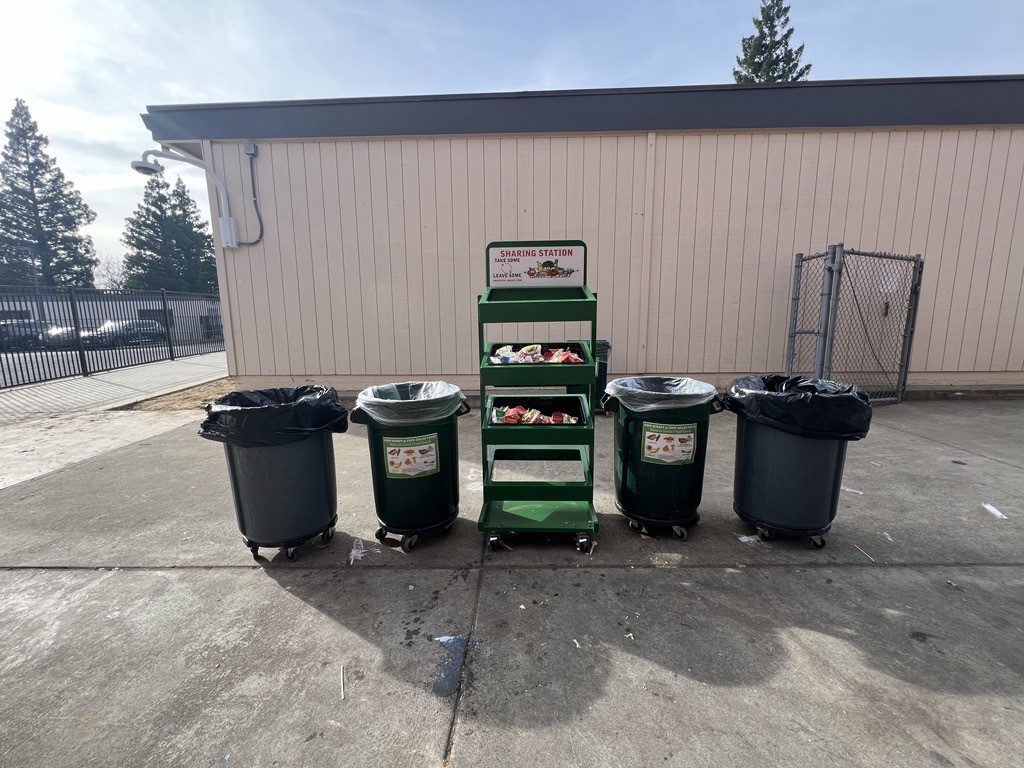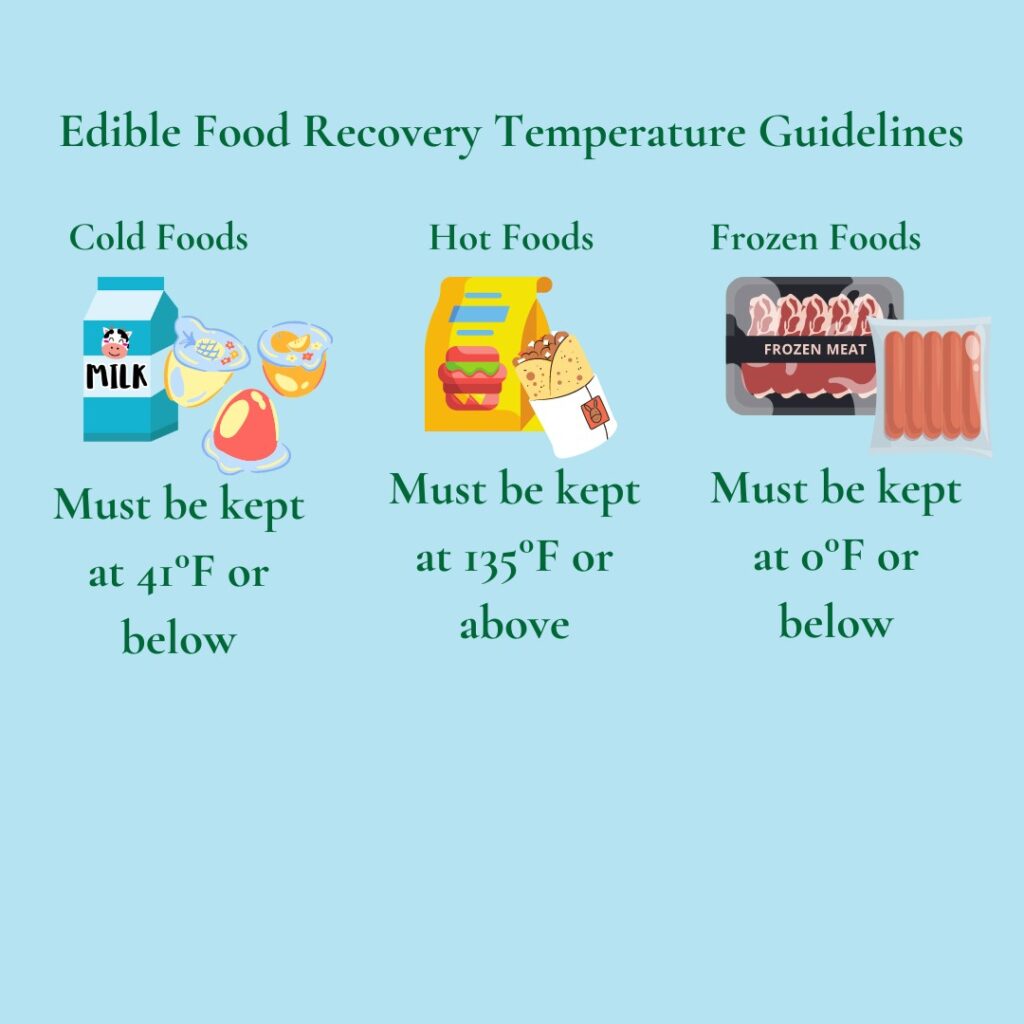
Decoding Food Recovery
As we continue to enter the new year, we welcome positive, sustainable change. While we have made significant improvements by introducing organic waste recycling, we are now moving on to the next phase of SB 1383. The next phase of SB 1383 focuses on edible food recovery, an important initiative that combats food waste while nourishing families in our communities. Diverting surplus edible and packaged food from our landfills into our communities helps reduce harmful methane emissions.
EDIBLE FOOD RECOVERY
On January 1st, 2024, the state mandated edible food recovery initiative came into effect for tier 2 generators, which includes schools! Let’s discuss a few key points about this new system and introduce some helpful information.
SB 1383 aims for food generators to recover all their excess edible food. This goal is part of a California initiative to recover 20% of the state’s edible food. A written agreement must be established and maintained between the schools and the respective food recovery organization or service. Our friends at CalRecycle have created a template for the written agreement that you can use. These records are subject to annual inspections to ensure compliance.
Some information that needs to be logged in food recovery includes the organization’s name, address, types of food being recovered, and the frequency of recovery. A full description of the requirements for record-keeping can be found on CalRrecycle’s website.
Our Food Scraps & Recycling team has been working closely with schools across Sacramento to incorporate organic waste recycling into their waste stations. While introducing our program, we have collaborated with schools to recover edible and packaged food.
THE SHARE CART
Schools have already been practicing food recovery with designated share cart stations in the cafeteria. A share cart in the waste station is a great way to help feed kids and divert food waste from landfills. Students are encouraged to grab extra food and snacks for the day from the share cart. If there are any surplus items, schools can donate them with the new edible food recovery initiative. Although share carts are not mandatory, they will be helpful in collecting unopened packaged food for food recovery. Children are encouraged to place their additional unopened packaged food at the cart to be shared with their peers. Share carts can have an insulated tub to store dairy and other refrigerated products. Eligible items such as whole unbitten fruits, unopened packages, and other shelf-stable items can be reserved. Foods that require certain temperature requirements or surplus kitchen goods can be designated for donation instead (ibid). CalRecycle has created a template for schools to maintain records of their surplus.

GENERAL TIPS & SAFETY ON FOOD RECOVERY
Edible food recovery can be difficult to navigate. Our team has some food recovery facts and safety requirements to keep in mind. Almost all food served can be donated, including meat and dairy. However, there are handling requirements that must be followed. For instance, frozen food items must always be kept at 0 °F or below. Cold foods need to stay in a 41 °F or below temperature window, while hot food items need to be kept at 135 °F or above. These conditions must be maintained in transport and can be achieved with thermal blankets and refrigerated vehicles. More information on food safety requirements can be located from the Safe Surplus Food Donation toolkit.

EXAMPLES OF FOOD RECOVERY IN SCHOOLS RIGHT NOW
Sacramento County has compiled a list of food recovery organizations in the area. We encourage schools and other tier 2 generators to reach out to an organization and establish a food recovery plan to maintain compliance with SB1383. Some California schools have already started implementing their edible food recovery programs. For example, schools in the Oakland Unified School District and the San Diego Unified School District have implemented food share tables and food donation programs to curb food waste. These districts have even created a customizable roadmap to help guide districts toward the reduction of food waste and the creation of a food recovery program.
The San Diego Jewish Academy (SDJA) has introduced a dining program that provides nutritious meals to over 750 community members each day. Through this program, SDJA has successfully diverted 100 percent of their school’s food waste 6. At the end of the day, edible food is donated to a food recovery partner which redistributes the meals to those in need. Further food scraps from the kitchen are converted into food for animals at local farms or used in the school’s garden compost. School members and faculty state that the program has instilled a sense of responsibility and sustainability for the school and the community.
Schools in Shasta County have introduced “Free Little Pantries” as a mechanism to reduce food waste. Food leftovers at the end of the day are distributed to several pantries in the surrounding area to feed local students and families.
CALRECYCLE RESOURCES
CalRecycle offers an extensive list of free resources that may be helpful to local jurisdictions and schools who are curious about food recovery implementation. These resources include a model food recovery agreement, which provides food donors with a comprehensive outline for establishing agreements with food recovery organizations.
In addition, CalRecycle provides food donors with a Safe Surplus Food Donation Guide and a Safe Surplus Food Donation Toolkit containing in-depth food safety information, such as food temperature requirements, and expiration dates. Furthermore, CalRecycle provides a food bank locator tool to help local education agencies and food donors locate food recovery organizations and food banks in their area.
OUR SUGGESTIONS TO REDUCE FOOD WASTE
Our team has suggestions to mitigate food waste based off firsthand experience and with USDA and the California Department of Education research. Lunch staff can inform students that they don’t need to take certain items which includes popular food items such as milk. A salad bar is another way to reduce food as waste, as kids can take their own desired portion of food. Schools could also consider keeping track of commonly wasted or uneaten foods in their schools and order more well received items; the USDA suggests schools try to get student feedback,
Moreover, extending the time allotted for lunch can help reduce food waste, allowing kids to have more time to eat.
CONCLUSION
Edible food recovery takes us closer to achieving a more sustainable future. Together, schools and partner food recovery organizations/services can help reduce food waste, methane emissions, and help fight food insecurity.
Co-written by Sharon Kaur, Parisa Kavousi, and Paige Arrnett